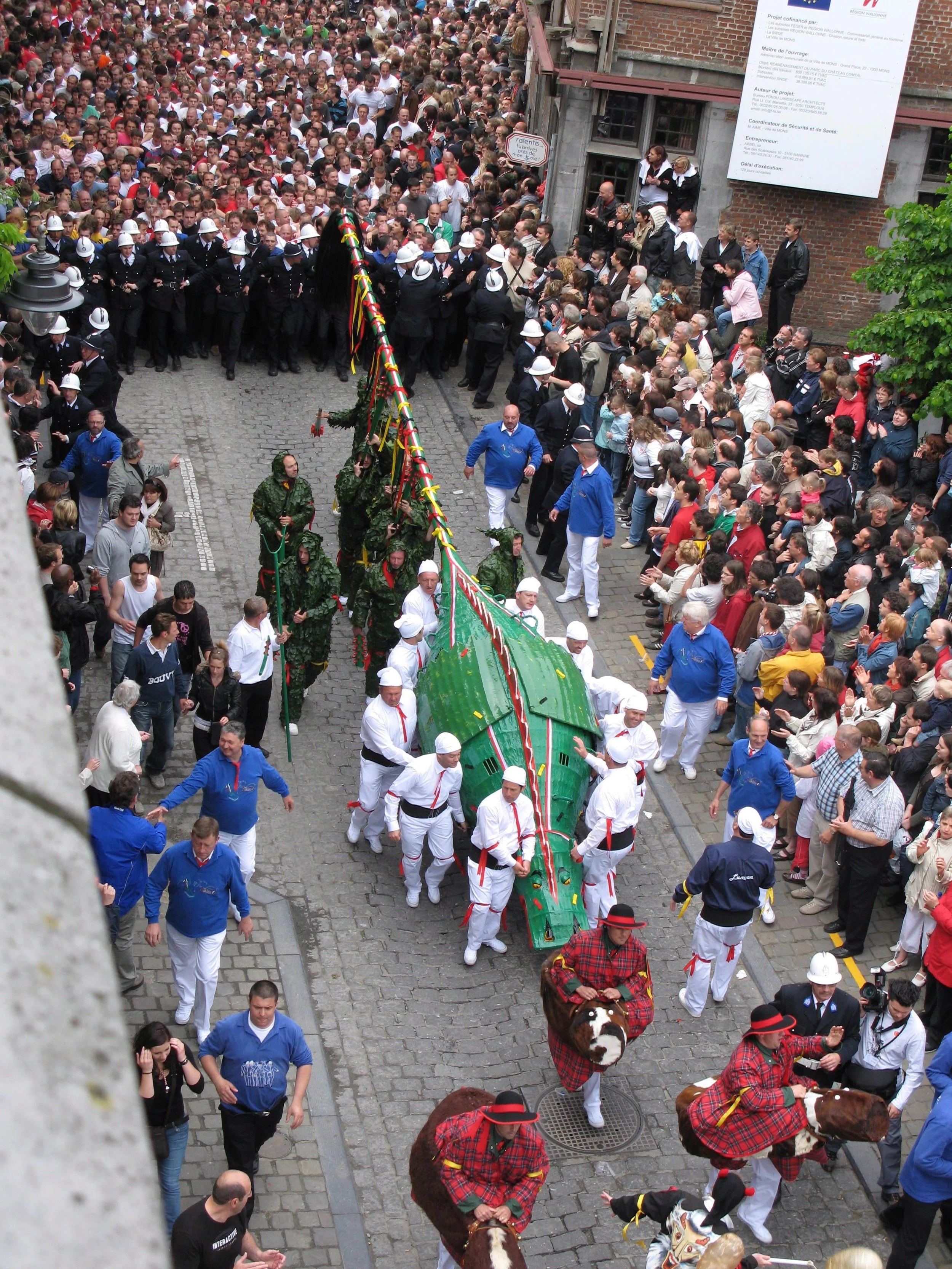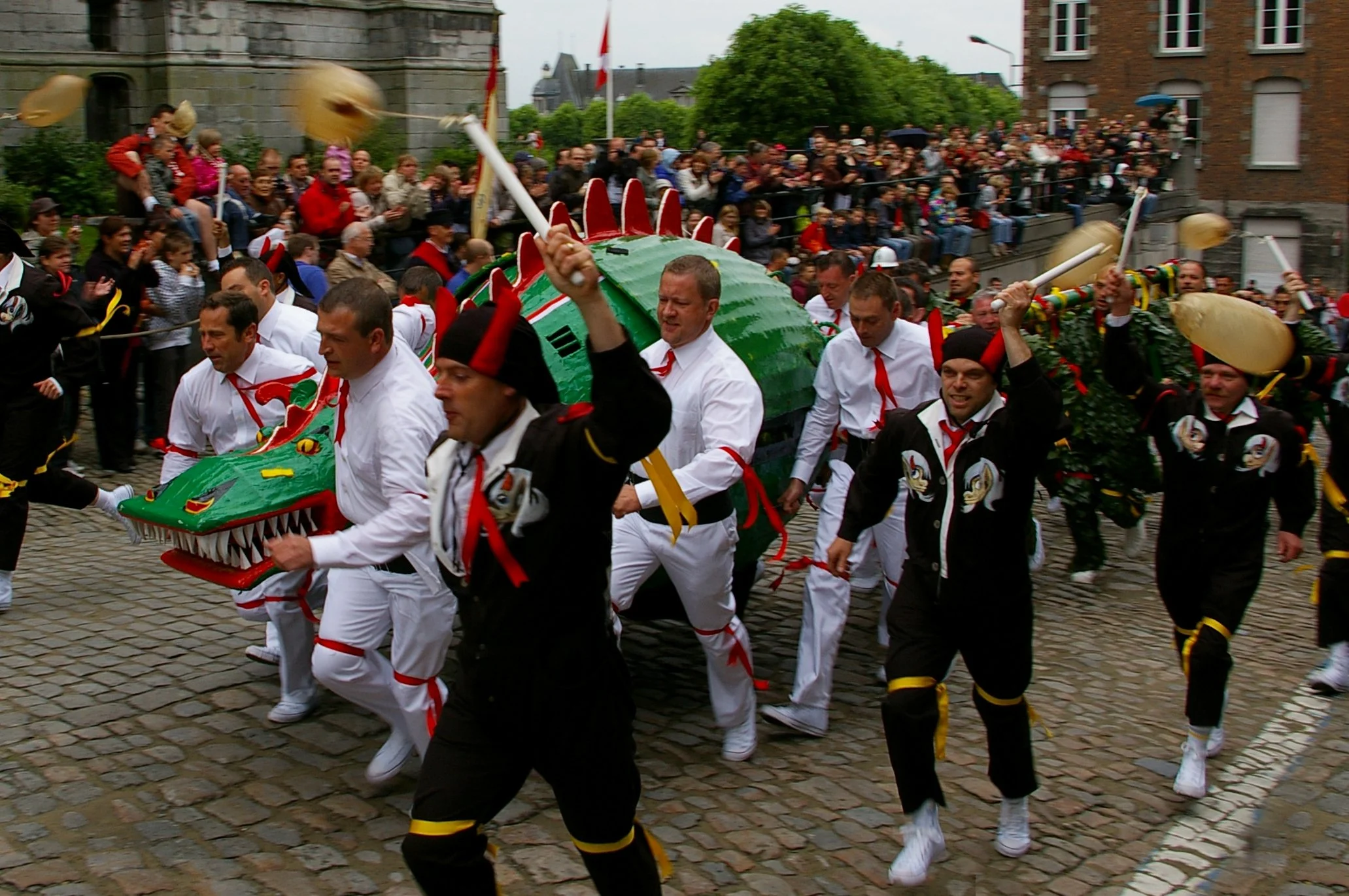What is the Doudou?
The Descent, the Circumambulation, and the Ascent
High in the rafters of the collegiate church of Mons is the gilded casket that holds Waltrude's remains. Every year on the Friday before Trinity Sunday, the casket is removed from its place and the dean of the collegiate church ceremoniously requests the aide of the secular authorities to protect it as the clergy are about to take the relic out of the church and process around the city with it. The casket is moved into a gold carriage and drawn by many horses. Following them are a parade of clergy, guilds, fraternal orders, and civil servants.
Once the carriage returns to the church, it has a twenty degree incline it has to overcome. It weighs a considerable four tons. Legend has it that if the cart cannot make the ascent in one go, grave misfortune follows. The cart would not go up in 1914, 1940, and did not rise during 2020 and 2021.
The Fight
The scene of the battle is the main square of the city. Mons shuts down for the whole day. Surrounded by sixty thousand people, various actors battle it out in a circle. The traditional name for the fight is Lumeçon, from the word limaçon, a French word evoking an infinite spiral.
The dragon spins and spins, swinging its tail at Saint George and his hunting dogs. The dragon is not alone and is aided by devils and wild men who attack not only Saint George and his dogs, but also the crowd gathered who wish for the beast to die.
At choreographed points in the fight, Saint George is able to strike the dragon with his spear, but each time he swings, the spear breaks on the dragon’s hide. The dragon’s scales are impenetrable. Armed with only a saber, the devils attack the hunting dogs who are trying to give Saint George a fresh spear.
After all spears have been broken and all seems lost, a woman presents Saint George with a pistol. He tries to shoot, but it symbolically jams. Only when he is given a second pistol does it fire, hurting the beast. The dragon attacks the crowd before collapsing, and Saint George delivers the final blow with another shot of the pistol. The beast is slain.
El biète est morte!
Heroes
Saint George
Dressed in the battle uniform of a Napoleonic soldier, he wears a brilliant yellow surcoat with red weaving and a cuirassier helmet and sits atop a black horse. The horse is braided with white and red ribbons. Together, the colors represent the flags of Mons, Hainaut, and Belgium.
Saint George fights the dragons with three weapons: a spear, a saber, and a handgun. He has three different varieties of spears that he uses in his quest against the dragon: a gold red-tipped spear, a red gold-tipped spear, and finally a black and white spear.
The Chinchins
The hunting dogs of Saint George, their leader is the Chinchin Protector. They wear a tartan coat. Their job is to wrestle and beat away the devils that are interfering with the fight.
Cybele
The first of the only two women to participate in the fight, she represents the primeval world. She has the power to revive fallen Chinchins and gives their Protector new spears to replace the ones that Saint George has broken in his fight.
Poliade
The second woman, she represents the modern world. After all spears have been exhausted, she gives Saint George a firearm to defeat the dragon.
Villains
The Dragon
A green monstrosity with thick skin and a tail as long as a tree, its mouth is open and filled with teeth. Affectionately called El Biète in the language of Walloon, from the end of its tail sprouts black horse hair. It spins counterclockwise, swinging its tail toward Saint George and his dogs. Symbollically, Saint George and his horse will catch the dragon's tail and force it to reorient clockwise. In anger, the dragon will smash its tail into the crowds gathered to attack those cheering Saint George on to defeat the beast.
The Devils
They cause chaos for Saint George and his hunting dogs, even going so far as to attack the crowds.
The Wild Men
They support and guard the tail of the dragon with large spiked clubs. With considerable force, they pull the dragon’s tail from out of the crowd.
The White Men
They represent the dragons legs as it moves around the arena. Functionally invisible, their role is fundamental to the fight as they direct the dragon's movement.




